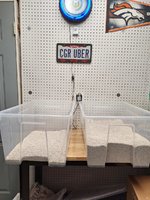I use it unsifted for deciduous trees for its higher water holding capacity and higher cation exchange capacity compared to pumice and lava. Carpinus caroliniana and Acer rubrum in particular grow well in wet soils, so I'm not worried about short periods of poor aeration right after watering. Fagus, Liquidambar, Ulmus, and Lagerstroemia spp. transpire so fast that the mix quickly dries anyway between waterings, and even most Quercus spp. don't seem bothered by the finer mix, although they mostly grow in drier upland soils in nature.
I have just a handful of conifers, so I used a similar NAPA-based mix, and they don't seem to like it. My Pinus taeda and P. Virginiana suffered fungal issues this year, so I plan to keep them drier and plant them in a pumice-based mix moving forward.
It seems most bonsai soil advice is tailored to pines and junipers, but there's plenty of trees, (e.g. Taxodium distichum) that thrive in wetter conditions, and we should be focusing more on species-specific mixes, rather than a one-size-fits-all mix.
Take that with a grain of salt. I still have a lot to learn, but I figured my experience was still worth sharing.



